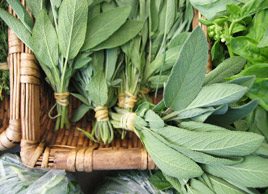How sage can help your health
Move this healthy herb to your medicine cabinet’sage is not just for cooking anymore

Source: Best Health Magazine, November/December 2008
Think sage and you probably picture hearty roast dinners. But aside from its qualities as a classic ingredient in stuffing, sage has lesser-known powers as a natural remedy. Used for treating conditions from cankers to memory loss, it’s more than just your average kitchen herb.
A history of sage
There are many species of sage, which is part of the mint (Lamiaceae) family. The name salvia derives from the Latin salvere, meaning ‘to be saved”a sign of its value throughout history. Common sage (Salvia officinalis) has a peppery taste and has been used for centuries to flavour food. Beyond the kitchen, it has been associated with potent healing powers. (A different species, Salvia miltorrhiza, is used in Chinese medicine.)
‘Traditionally, it was used to treat fevers, as a calming tea to help people get to sleep, and for colds,’ says Paul Saunders, a naturopathic doctor and professor at the Canadian College of Naturopathic Medicine. Now, modern science is corroborating some of its historical uses.
Evidence of what sage can do
Sage has a long history of treating ailments of aging such as memory loss and Alzheimer’s disease. Researchers in Iran have shown that extracts of Salvia officinalis improve cognitive function in patients with mild to moderate Alzheimer’s disease, and may reduce agitation. And in 2003, researchers at Northumbria University in the U.K. found that healthy adults who had taken Spanish sage oil had a higher word recall than the other participants.
These findings have been confirmed in other studies, too. Acetylcholine, a chemical messenger in the brain, is found in lower levels in patients with Alzheimer’s disease. Sage is believed to inhibit the loss of this chemical, though researchers are still unravelling the science behind it. ‘It’s pretty exciting because we don’t have much to offer [for Alzheimer’s],’ says Saunders.
Sage’s other benefits
In vitro studies have shown that the herb can kill bacteria such as E. coli and stave off fungal infections.
An effective antioxidant, sage can also soothe indigestion and dyspepsia when ingested as an herbal tea. Worked into your dental routine, it is also an effective mouthwash to combat gum disease, cankers and throat infections.
Believed to have an estrogenic effect, sage was traditionally taken by women hoping to dry up their breast milk supply, or to relieve hot flushes during menopause. It hasn’t been clinically proven, but the fact that sage is high in astringent tannins supports this use.
Therapeutically, sage is available in tinctures, capsules, teas and essential oils. Some of the active constituents in the herb are thujone, cineol and limonene, found in its volatile oils, and rosmarinic acid.
Cautions and interactions
The thujone content of sage essential oil can be toxic in large amounts, but that isn’t usually a problem when the plant is grown in colder climates. But to be safe, it should be avoided during pregnancy and lactation, says Saunders. Due to its astringent quality, too much sage tea can cause a dry mouth, and skin irritation can occur with topical use. So when making a calming tea, he advises blending sage with catnip (nepeta cataria), lavender or mint.
Home remedies using sage
You can create your own natural treatments for common ailments and conditions using sage. It’s available in most health food stores and any store that sells herbs. It’s also easy to grow.
‘ Toner for oily skin
Add a spoonful of sage to a cup (250 mL) of boiling water. Steep for 30 minutes, strain and let cool before dabbing on your face.
‘ Sore-throat gargle
Put a large pinch of dried sage leaves into about a half cup (100 mL) of water. Bring to a boil and infuse for 15 minutes. Strain, sweeten with honey and use as a gargle twice a day.
‘ Canker relief
Gargle strong sage tea or freeze it into ice cubes and pop one in your mouth to soothe cankers.
‘ Hair rinse
Add a couple of pinches of sage leaves to about a 1/4 cup (50 mL) of boiling water. When cooled, use it as a rinse to treat dandruff or to lift lacklustre locks.
This article was originally titled "Sage Advice," in the November/December 2008 issue of Best Health Magazine. Subscribe today and never miss an issue!




